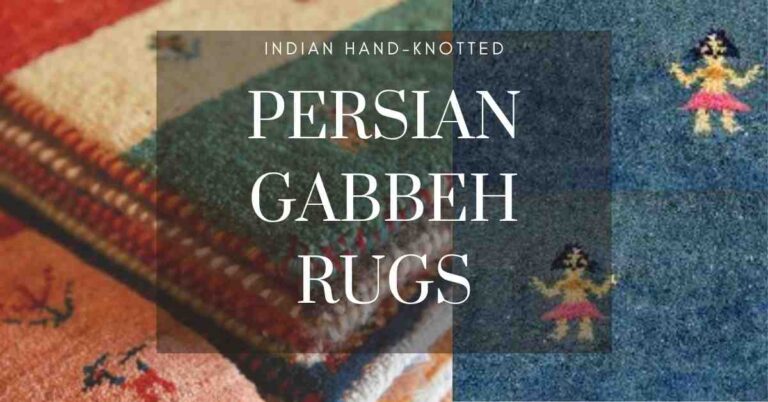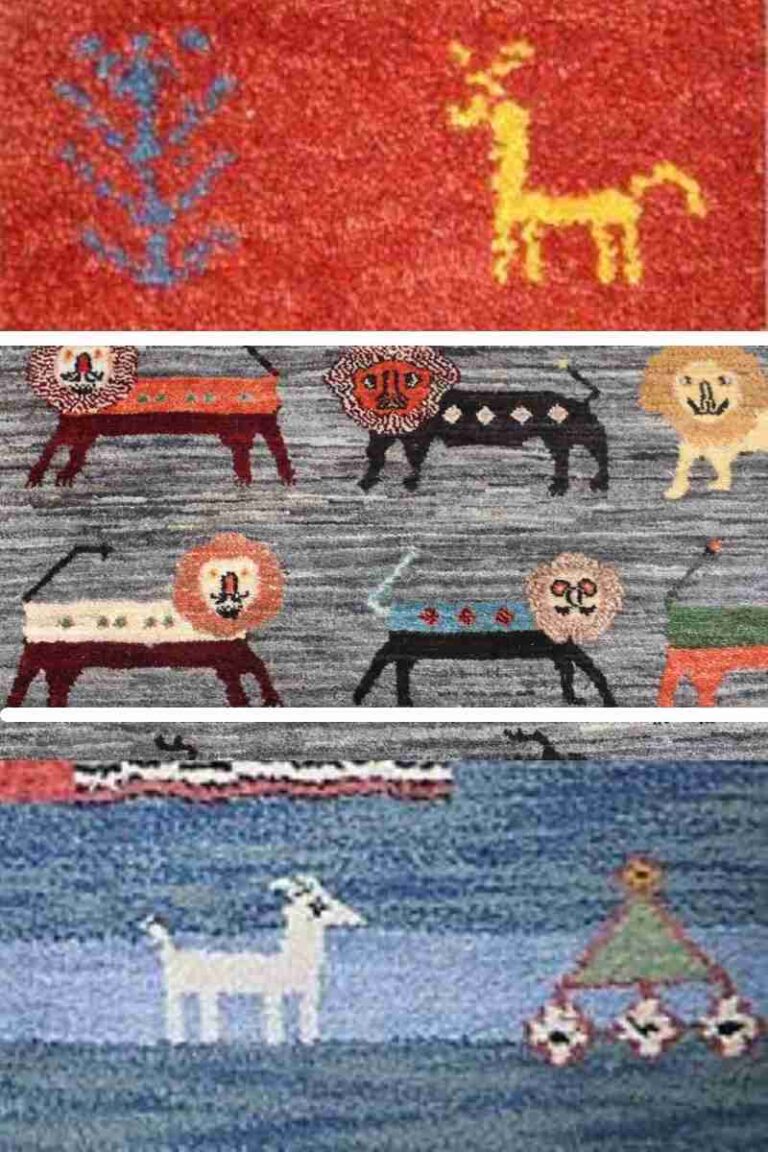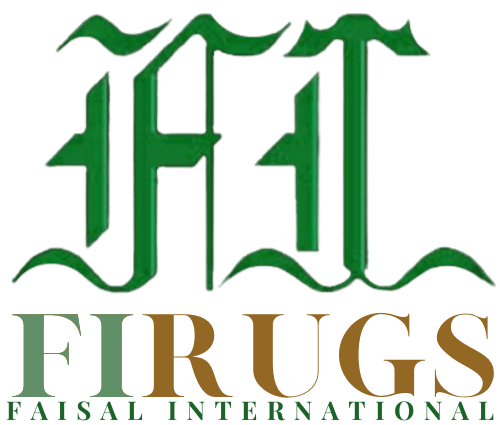
Table of Contents
Perisan Gabbeh Rugs | Handmade Indian Rugs In Wool
Persian Gabbeh rugs fall under the Persian rugs category and differ from the rest of them because of the unique color texture at the face of the rug.
Gabbeh wool rugs are inexpensive compare to other forms of Persian area rugs.
Significance Of Indian Gabbeh Rugs
Indo Gabbeh rugs from India have gained a rapid reputation in the West since the start of the 1980s.
FiRugs has been a producer of genuine Indo Gabbeh carpets and Gabbeh runner rugs for several Gabbeh oriental rug importers in large quantities and the most authentic quality.
For quality wool Gabbeh rugs prices or order placement for any handmade Indian rugs, contact us.
What Is Gabbeh Rugs Meaning?
Gabbeh means raw or natural in Farsi, the Persian language. It can also refer to something rough and uncut. Traditionally, the Gabbeh carpet runners and carpets were made for the personal use of the tribe, but ever since it came to the West, it has been made commercially for sale.
Hand-knotted Gabbeh carpet weaving takes a considerable amount of time in making, depending on its quality. Usually, it takes 5-8 weeks to weave a piece size of 5’x8’.
Brief History
Women make Gabbeh from the Qashqai, Kurdish, and Luri tribes in Iran. These people come from the Zagros Mountains and their surroundings. The rugs have been made for many years and are still hand-woven by these women today.
New And Antique Gabbeh Rugs Online
Colors In Kashkuli Gabbeh Wool Rugs
The colors used in the wool yarn for Gabbeh tribal rugs are usually vibrant bright earthly colors like red, orange, blue, yellow, green, brown, white, etc. These colors are natural dyes made from plants and vegetables.
Some of them from which the colors are extracted include walnut shells, pomegranate skin, madder root, and even indigo.
The dyes are made according to the recipe passed down for centuries. As these dyes are made from natural dyes, colors sometimes vary across the carpet, making the rugs more unique and distinct.
Loribaft Gabbeh Rugs Pile
When you look at the a hand knotted Gabbeh rug quality, you will see that it has a very thick pile. It is made of wool and has a low density of knots used. Carpet patterns are usually geometric and have symbolic designs representing people, animals, and other everyday objects.
The rugs themselves tell a story or illustrate a scene or landscape. Sometimes these rugs are used to allow women to describe their emotions. So you can see how handmade Gabbeh wool area rugs capture the unique art and spirit of these tribal women.

Fringes In Indo-Gabbeh
Fringes are essential to help determine and identify the authenticity of any hand-knotted rug, including the Gabbehs.
Now, contemporary Gabbeh knotted rugs come in fringeless styles. So, where do the naturally occurring fringes go? Well, it doesnt go anywhere; it is still there but made to be hidden on purpose. Hiding the cotton fringe makes the design look more intact in a frame.
How Are Fringes Hidden?
- The fringes are first combed, cleaned from debris, and slightly trimmed to form an even size across the entire edged of the rug.
- In the following process, the fringes are woven in the simple, alternate weaving technique. It is a process called “khati” making. In khati weaving, it uses the same wool as the rug with the rug’s primary background color.
- The fringes are then flat padded in a straight line behind the rug.
Binding
Every handmade carpet has a binding to its open ends. While the fringes secure the horizontal ends, wool binding ties up the vertical ends.
Generally, binding follows the same rule of thumb, but binding can be treated uniquely with modern Gabbeh rugs. How? Unlike others, these carpets can have regular to various binding styles such as tilt pattern binding and binding with dual colors, etc.
Traditional Gabbeh Rug Cleaning
FiRugs recommends getting your Lori Gabbeh or any Persian rug cleaned by professional rug cleaners at least once every two years.
Professional cleaning is expensive and simple ways can help eliminate those extra charges.
Firstly, so that the wool does not accumulate soil and dirt, it is essential to vacuum regularly.
Make sure always to prefer to spot clean to eliminate out any dirt.
Use any good carpet cleaner available online or clean with home remedies using vinegar, baking soda, detergent. For a more detailed cleaning guide, click here.
Unique Dyeing And Texture
The wool used for Gabbeh production uses handspun yarn. Spinning wool yarn by the hands creates a twist that plays an important role in creating authentic Gabbeh rugs.
There is a slight difference in the dying method for Gabbeh wool yarn, where the timing does matter to achieve the right texture.
The natural color dye reaches the twisted and dense yarn in different absorption rates creating a unique striation and mottled texture to the face of the rug once trimmed.
Designs And Symbols In Gabbeh Area Rugs
Rugs of this type are often geometric in shape. Although the colors differ from rug to rug, a single rug piece may have large portions in just one color.
They are often designed borderless but may have a border as well. As the weavers are mostly women, you will see scenes depicting daily village life, animals, and folklore.

Gabbeh Rug Symbols And Meaning
If you observe designs closely, Gabbeh and kilim rugs nearly follow the same tribal patterns.
Some regular are human figures, goats, deer, birds, girls in frock, hills, trees, triangles, boxes, etc. Know what some of the common symbols in the rug mean:
- The Tree of Life – The tree of life rug represents faith in eternal life.
- A Pomegranate – The fruit symbolizes abundance.
- Lion – shows heroism and triumph.
- A Comb – signifies cleanliness and brings good wishes of good wellness for the family.
- Camel – typically associated with prosperity and happiness.
- Peacocks – These sacred birds represent man’s spirituality.
- Dog – defends man against his self misdeeds and the harmful actions of others.
- The Cock – woven into rugs, it is believed that it protects the owner from evil.
- The Hourglass – symbolic of how things change for the family over time.
- Clouds – showers joy to the family.
- Cypress Tree – represents life after death.
FAQs
Where are Gabbeh rugs made?
At present, Gabbeh area rugs are widely made in India, which is why they have earned geographical popularity tagged as “Indo-Gabbeh rugs.” Pakistan also produces them in equally good quality.
Historically, they are native to the Zagros Mountains of Persia (today called Iran). The Kashkuli, Luri, and Kurdish tribes make them. Traditionally, it used to be that all weavers were female, but today many men are weaving as well.
Counterfeit goods made from cheap cotton and wool are available on the market. These now mainly come from India and Pakistan.
How to tell a genuine Gabbeh rug from a fake piece?
A fake piece may look similar to the real one, but there are ways to identify them. The actual piece will have a wool foundation, while the fake has a cotton foundation.
The real rug piece will have white fringes that form up naturally with the development of the rug. The wool yarn is handspun with twists and has a noticeable color variation on its face when sheared at the finish.
Different between Gabbeh and other types of Persian rugs?
Their texture is thicker than the average Persian carpet, and its depth is sometimes up to an inch deep. The weaving process uses thick knots, which are responsible for the depth. When cared for properly, these rugs are incredibly durable and can last a lifetime.
- Pile height is normally a bit longer than other Oriental carpets.
- Made from twisted handspun yarn that is thicker, forming denser and plush texture.
- Follows a different technique in dyeing the wool that forms regular color variation naturally.
- Less expensive compared to complex designed Persian area rugs as they have lesser knots per square inch.
What is the best Gabbeh persian carpets made of?
An original Gabbeh piece will always have woven with a good quality hand-spun yarn and never with a machine-spun one. The dyes used for coloring the wool will carry natural vegetable dyes and never be dyed chemically.
They are very soft to the touch, and the rug’s surface will have natural color variation and dual to trio color mottled texture across the whole carpet.
Are Gabbeh rugs soft and durable?
Yes, the indo Gabbeh style rugs are as soft as any woolen rug because wool is a soft material, of course. However, they are not as smooth as NZ wool-made rugs, and this is how they should naturally feel. It is highly durable as well, which is the most appealing factor to invest in them.
Bottom Line
Kashkuli Gabbeh rugs are more than just a work of art; it is an investment that will last a lifetime. Compared to other handmade rugs, these rugs have a thick and dense pile sometimes utilized for sitting and also sleeping.
The simple design elements make them ideal for use in modern interiors. Although not recommended for formal spaces, they can go well with classic interiors if carefully chosen.
